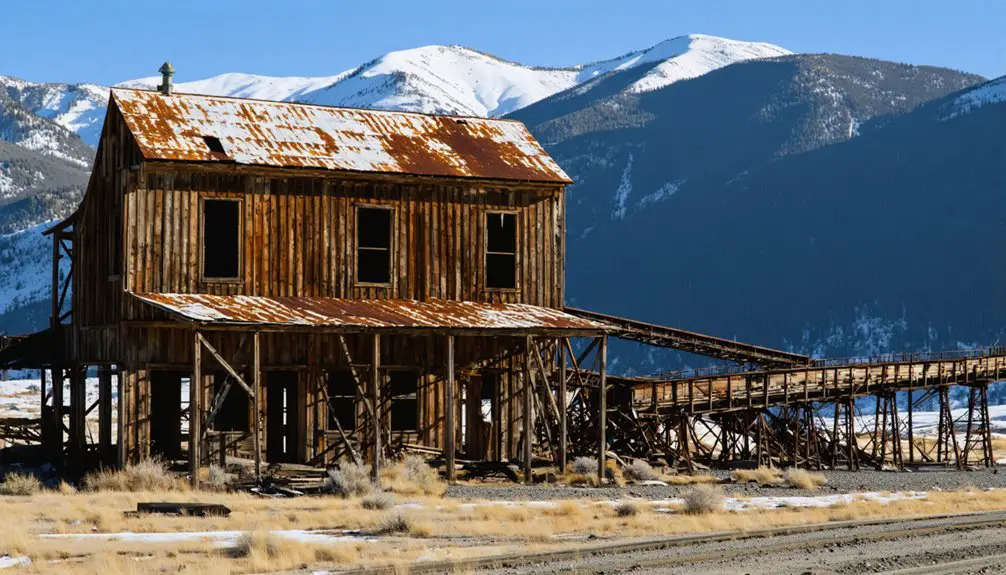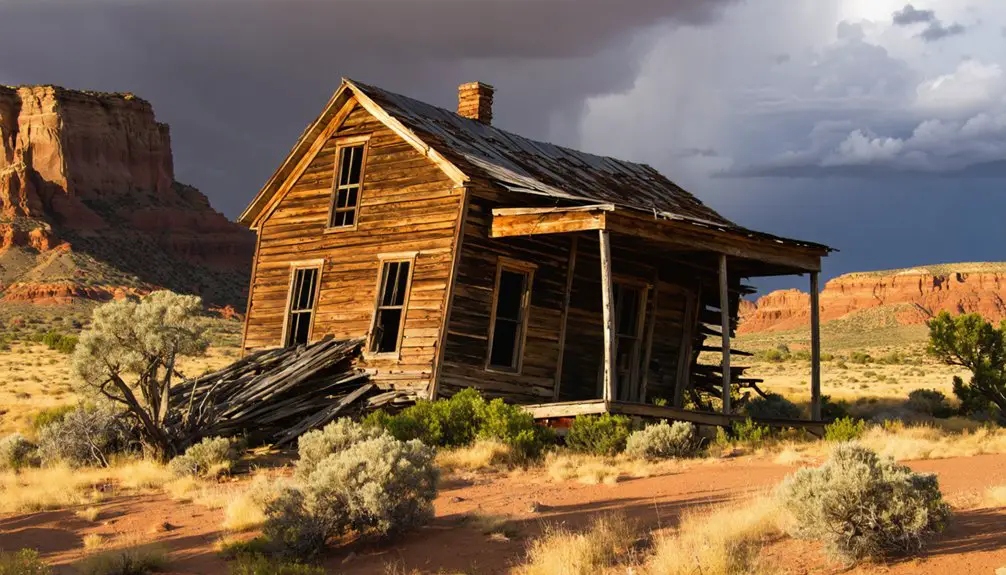You’ll find Alunite, a WWI-era ghost town, nestled in Utah’s Cottonwood Canyon, where Thomas Gillan discovered rich alunite ore deposits in 1912. The Mineral Products Corporation built a thriving company town, complete with housing, stores, and an aerial tramway system. The site produced essential potash for military explosives until 1918, when post-war market changes forced its closure. Today, weathered foundations and rusted mill equipment tell a compelling story of wartime industry and sudden decline.
Key Takeaways
- Alunite was a mining town established in 1912 near Marysvale, Utah, following Thomas Gillan’s discovery of significant alunite ore deposits.
- The town featured company-built infrastructure including a reduction mill, store, housing, school, and aerial tramway system for ore transportation.
- The community thrived during World War I, producing crucial potash for military explosives after German imports were cut off.
- Post-WWI decline occurred rapidly due to plummeting potash prices and increased foreign competition, leading to the town’s abandonment.
- Today, the ghost town contains deteriorating ruins, rusty mill equipment, and old building foundations approximately 4.5 miles southwest of Marysvale.
The Discovery of Alunite Ore and Early Settlement
The discovery of alunite ore in Utah’s Cottonwood Canyon marked a pivotal moment in the region’s mining history. In 1912, prospector Thomas Gillan stumbled upon striking veins of rust to pink-colored spar that would transform this quiet canyon into a bustling mining operation.
The mineral composition proved remarkable – you’d find about 38% aluminum, 37% sulfur, and 11% potash in the rich deposits that measured 52 feet wide and up to 35 feet thick. Mining companies found the deposits particularly valuable due to their vitreous, pearly luster.
Rich alunite veins in Utah revealed extraordinary mineral content: 38% aluminum, 37% sulfur, and 11% potash across massive deposits.
The historical significance of this find became clear when A.E. Custer in Salt Lake City and the Foot Mineral Company in Philadelphia confirmed the ore’s value. Soon, the U.S. government took notice, recognizing alunite’s potential as a domestic source of potash for fertilizers and explosives. The area contained 30,000,000 tons of alunite deposits, making it the largest known source in the United States.
This discovery would later prove essential during World War I‘s resource demands.
Building a Mining Community in Cottonwood Canyon
Following the discovery of alunite deposits, Mineral Products Corporation established a vibrant mining community on Deer Trail Mountain’s eastern slope, about 15 miles south of Marysvale.
The company invested $100,000 to build essential infrastructure, including a reduction mill, company store, and employee housing to support their pioneering potash extraction operation.
The community dynamics reflected typical mining culture of the era, with workers and their families relying heavily on company-provided services. The area contained vast mineral wealth, making it one of Utah’s most valuable mining regions.
You’d find a school for the children and a post office, but residents traveled to Marysvale for church services and shopping.
An innovative aerial tramway system, complete with telephone lines, connected the mine to the processing plant, while the nearby railroad enabled efficient shipping of processed materials to distant markets.
The mining operations thrived until World War I ended, causing a significant decline in alunite demand and eventual shutdown of the mines.
Strategic Importance During World War I
When America entered World War I in 1917, you’d find Alunite’s mining operations working around the clock to extract potash for military explosives, as German imports had been cut off since 1914.
The town’s strategic value drew intense government scrutiny, with officials investigating reports of enemy spies and potential sabotage attempts at the processing facilities.
You’ll notice that despite producing only 4-7% of America’s wartime potash needs, Alunite’s role as the nation’s sole domestic source made it a crucial asset in the war effort. The area’s vast open spaces made it an ideal location for military operations, a strategic advantage that would later prove valuable during World War II as well.
War-Time Production Surge
As World War I disrupted Germany’s potash exports to America, Utah’s Alunite deposits suddenly gained strategic significance for the nation’s fertilizer and explosives production.
You’d find the Mineral Products Corporation leading the charge, rapidly developing large-scale alunite extraction operations near Marysvale to meet wartime demands.
The numbers tell the story of this remarkable surge: workers extracted up to 262,000 tons of alunite ore during the war years, processing it into 20,000-30,000 tons of essential potassium sulfate.
The newly constructed mill near Cottonwood Canyon operated around the clock, while the town of Alunite grew to support over 100 workers with basic amenities.
Though the operation only contributed 4-7 percent of America’s total potash production, it proved pivotal in reducing the nation’s dependence on foreign supplies.
Security Against Enemy Sabotage
Given its critical role in America’s wartime potash supply, the Alunite mining operation faced serious security threats from potential enemy saboteurs during World War I.
You’ll find that the U.S. government didn’t take these threats lightly – they implemented round-the-clock security measures to protect this crucial domestic resource from foreign spies and saboteurs who attempted arson and bombings at the facilities.
The sabotage prevention strategy included surveillance, restricted access, and constant monitoring through a 24-hour workforce. Today, visitors to St. George, Utah can explore remnants of these historic security measures.
Reports of suspicious fires at plant facilities heightened concerns about enemy agents, leading to increased coordination between federal officials, plant management, and local communities.
This vigilance proved essential, as the mine’s potash production directly supported America’s munitions manufacturing efforts, making it a prime target for those seeking to disrupt the war effort.
Mining Operations and Industrial Infrastructure
Following the 1912 discovery of a rich alunite vein in Cottonwood Canyon by prospector Thomas Gillan, Mineral Products Corporation transformed the site into a substantial mining operation. The company invested $100,000 to tackle industrial challenges in extracting potash, aluminum, and sulfuric acid from the unique ore deposit.
You’ll find the mining techniques were quite advanced for their time, with the operation including a reduction plant built specifically for processing alunite ore. The facility employed over 100 workers during its peak, running 24-hour shifts focused on potash extraction for wartime needs.
While the operation succeeded in producing 4-7% of America’s potash during WWI, the site’s industrial infrastructure extended beyond mere production facilities to include worker housing, a company store, school, and post office.
Post-War Decline and Abandonment

You’ll find that Alunite’s swift decline began after World War I when potash prices plummeted and foreign imports flooded the market, making local mining operations economically unsustainable.
The town’s population, which had peaked at over 100 employees during wartime production, dwindled rapidly through the 1920s as mines and mills shut down, despite a brief revival attempt during World War II. Similar to silver mining wealth in Frisco that generated over $20 million before its eventual abandonment, Alunite’s prosperity proved temporary.
The site’s rusty mill equipment scattered throughout the area serves as evidence of its industrial past. Today, the restricted-access site contains deteriorating ruins of industrial facilities and town infrastructure, standing as silent reminders to the boom-and-bust cycle of Utah’s mining history.
Economic Factors Behind Closure
While Alunite thrived during World War II‘s industrial mobilization, the town’s fate was sealed by a perfect storm of economic factors in the post-war period. The sudden drop in federal war spending marked the end of an era when 91% of industrial expansion had been publicly funded.
Market competition from cheaper foreign potash imports and South American bauxite crushed the local industry’s already thin profit margins. The town’s operational inefficiencies, including costly extraction processes and high transportation expenses from remote mines to processing facilities, made it impossible to compete without government support.
When federal wartime contracts and subsidies ended, Alunite’s economic foundation crumbled. The lack of affordable electrical power prevented aluminum production from becoming viable, while the alumina byproduct was relegated to minor industrial uses. The success of Utah steel plants elsewhere in the state highlighted Alunite’s inability to adapt to changing post-war industrial needs.
Utah’s broader economic shift toward urban manufacturing sealed Alunite’s destiny as global suppliers with larger economies of scale dominated the market.
Population Exodus Timeline
As World War I drew to a close in late 1918, Alunite’s population began a dramatic decline from its wartime peak of over 100 residents.
The population dynamics shifted rapidly as mining operations scaled back, with families departing steadily through the 1920s.
You’ll find that migration patterns show most residents relocated to nearby Marysvale as jobs disappeared and community services dwindled.
Structural Remnants Today
The physical remnants of Alunite stand as silent witnesses to its post-war decline, offering visitors glimpses into the town’s mining heritage.
You’ll find foundations scattered across the landscape, marking where buildings once stood during the town’s heyday. While structural deterioration has claimed most wooden structures, the mortared stone buildings have better withstood time’s passage.
Mining artifacts like rusted equipment and processing machinery dot the site, while extensive tailings piles reveal the scale of past operations.
The mine entrances remain visible in the hillsides, though they’re now unsafe to explore. Nature steadily reclaims the site, with vegetation growing through foundations and weathering gradually erasing traces of human activity.
Access is restricted due to private ownership and hazardous conditions.
Historical Legacy and Remaining Traces

Today you’ll find little more than scattered ruins marking the site where Alunite once thrived as a bustling wartime mining town. About 4.5 miles southwest of Marysvale, you can explore the remnants of foundations, weathered walls, and old mill installations that tell the story of this short-lived but strategically important settlement.
The cultural impact of Alunite’s rise and fall mirrors many Western ghost towns born from wartime necessity. What remains are traces of the reduction plant, aerial tram systems, and telephone lines dating to the 1910s – silent witnesses to an era when this remote Utah location played a vital role in America’s World War I effort.
The site stands as a memorial to the boom-and-bust cycle that shaped many mining communities across the American West.
Frequently Asked Questions
What Was the Average Salary of Miners Working in Alunite?
You’d have earned between $2-$4 daily in mining wages during Alunite’s peak, though exact figures aren’t recorded. The historical economy suggests wartime demand might’ve boosted your pay above average.
Were There Any Major Accidents or Deaths During Mining Operations?
In the darkness at 1:30 AM, Joe Parker died in a devastating cave-in. Mining hazards claimed multiple lives through collapses, premature blasts, and poor worker safety, much like Ed Dalton’s fatal blast injury.
What Happened to the Residents After the Town Was Abandoned?
You’ll find residents scattered to nearby towns seeking work, with their post abandonment lives centered in Marysvale and other Utah communities. Some joined WWII industrial efforts, while others pursued regional mining migration patterns.
Did Any Original Buildings or Equipment Survive Until Modern Times?
You’ll find only concrete mill foundations and partial walls remain today, with no complete buildings surviving. Despite their architectural significance, historic preservation efforts haven’t restored any original structures or mining equipment.
Were There Any Notable Conflicts Between Workers and Management?
Like a powder keg waiting to ignite, you’ll find little record of major labor disputes in Alunite, though nearby mining towns saw fierce conflicts over management tactics involving strikes and armed guards.
References
- https://en.wikipedia.org/wiki/Alunite
- https://www.onlineutah.us/alunitehistory.shtml
- https://archiveswest.orbiscascade.org/ark:80444/xv07473
- https://whileyoureintown.com/ut/marysvale/attraction/alunite-ghost-town
- https://utahrails.net/mining/marysvale-alunite.php
- https://www.govinfo.gov/content/pkg/SERIALSET-06233_00_00-002-0355-0000/pdf/SERIALSET-06233_00_00-002-0355-0000.pdf
- https://pubs.usgs.gov/bul/0886d/report.pdf
- https://trustlands.utah.gov/wp-content/uploads/2024/05/Krahulec-2008-Mineral-potential-of-the-Blawn-Wash-alunite-area-Beaver-County-Utah.pdf
- https://www.piuteutah.com/recreation-tourism/visit-piute-county/historical-info/
- https://pubs.usgs.gov/bul/0620k/report.pdf



